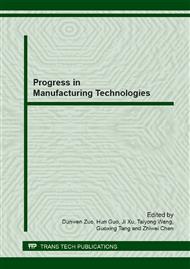p.45
p.53
p.59
p.67
p.73
p.81
p.87
p.91
p.101
Study on Modeling and Virtual Machining for Monolithic Multi-Frame Component Based on Aluminum Alloy 7075-T7351
Abstract:
Because the multi-frame component has thin walls, variable wall thickness and a high reconciliation precision request, the design restrains are many, and the variable is big, the manufacture restrains must be considered in the design stage. In this study, a method called “house-building frame modeling” is introduced firstly, and the finite element model of the milling distortion analysis is established for the multi-frame components by the method, and the prediction analysis of the milling distortion under different milling conditions is carried out, by means of 3-D finite element simulation technology. Comparing the simulation results and the measurement ones of the milling distortion, the proposed model is modified; the modeling method and prediction method are proved to be effective. Software system is developed specially for the modeling and the distortion prediction for multi-frame part. By using of the software, a platform structure with 192 frames is analyzed and its milling distortion is predicted successfully. reference on the purpose of optimizing milling coefficient.
Info:
Periodical:
Pages:
73-79
Citation:
Online since:
July 2013
Authors:
Price:
Сopyright:
© 2013 Trans Tech Publications Ltd. All Rights Reserved
Share:
Citation:


